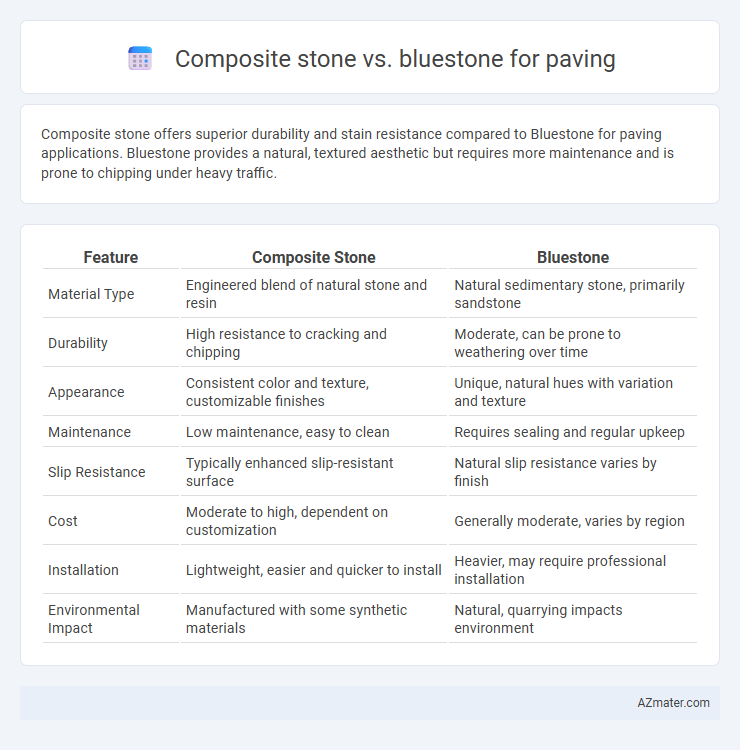Composite stone offers superior durability and stain resistance compared to Bluestone for paving applications. Bluestone provides a natural, textured aesthetic but requires more maintenance and is prone to chipping under heavy traffic.
Table of Comparison
| Feature | Composite Stone | Bluestone |
|---|---|---|
| Material Type | Engineered blend of natural stone and resin | Natural sedimentary stone, primarily sandstone |
| Durability | High resistance to cracking and chipping | Moderate, can be prone to weathering over time |
| Appearance | Consistent color and texture, customizable finishes | Unique, natural hues with variation and texture |
| Maintenance | Low maintenance, easy to clean | Requires sealing and regular upkeep |
| Slip Resistance | Typically enhanced slip-resistant surface | Natural slip resistance varies by finish |
| Cost | Moderate to high, dependent on customization | Generally moderate, varies by region |
| Installation | Lightweight, easier and quicker to install | Heavier, may require professional installation |
| Environmental Impact | Manufactured with some synthetic materials | Natural, quarrying impacts environment |
Introduction to Composite Stone and Bluestone
Composite stone for paving combines natural stone aggregates with resin binders, offering durability, resistance to weathering, and a wide range of customizable colors and textures. Bluestone, a dense, fine-grained sandstone primarily quarried in the Northeastern United States, is valued for its natural blue-gray hues, slip resistance, and traditional use in patios, walkways, and steps. Both materials provide unique aesthetic and functional benefits, with composite stone excelling in versatility and bluestone prized for its classic, natural appeal.
Material Composition and Characteristics
Composite stone for paving consists of engineered mixtures combining natural stone aggregates with resins or polymers, offering enhanced durability, stain resistance, and a consistent appearance. Bluestone, a natural sedimentary rock primarily composed of sandstone or limestone, is valued for its dense, fine-grained texture, natural cleft surface, and rich blue-gray coloration, providing superior slip resistance and weathering properties. While composite stone offers customization in color and strength, bluestone remains preferred for its authentic natural aesthetic and long-lasting performance in outdoor paving applications.
Aesthetic Differences and Design Options
Composite stone offers a wide range of color variations and modern textures, creating sleek and contemporary paving designs. Bluestone provides natural, earthy tones with unique veining patterns that enhance classic and rustic aesthetics. The choice between composite stone and bluestone significantly influences the visual appeal and style flexibility of outdoor paving projects.
Durability and Longevity Comparison
Composite stone offers superior durability compared to bluestone, as it resists cracking, chipping, and weather-related wear due to its engineered composition. Bluestone, a natural sedimentary rock, exhibits excellent longevity but is more susceptible to erosion, staining, and damage from freeze-thaw cycles over time. Both materials provide strong paving options, yet composite stone typically outperforms bluestone in maintaining structural integrity and appearance under heavy use and harsh environmental conditions.
Installation Process: Composite vs Bluestone
Composite stone offers a faster and more straightforward installation process due to its lightweight and uniform slabs, allowing for easier cutting and placement without extensive heavy machinery. Bluestone, a natural stone, requires skilled labor for handling irregular shapes and heavier slabs, often necessitating precise cutting and leveling to ensure durability and aesthetic appeal. The choice between composite and bluestone significantly impacts labor time, installation complexity, and overall project costs.
Maintenance Requirements and Ease of Care
Composite stone paving demands minimal maintenance due to its resistance to staining, cracking, and fading, requiring only occasional cleaning with soap and water to maintain its appearance. Bluestone, while durable, needs regular sealing to prevent moisture absorption and staining, and periodic cleaning to remove dirt and algae buildup, making it slightly more labor-intensive. Overall, composite stone offers easier care and lower maintenance costs compared to the upkeep-intensive nature of natural bluestone paving.
Cost Analysis: Upfront and Long-term Expenses
Composite stone typically offers lower upfront costs compared to bluestone, making it a budget-friendly option for paving projects. Bluestone, while more expensive initially due to quarrying and milling processes, tends to have superior durability and requires less maintenance over time, reducing long-term expenses. Evaluating total cost of ownership, bluestone's longevity and resistance to wear often offset its higher initial investment compared to composite stone.
Environmental Impact and Sustainability
Composite stone paving materials often have a lower environmental impact due to their use of recycled content and reduced quarrying requirements, which helps conserve natural resources and minimize habitat disruption. Bluestone, a natural sedimentary rock, involves significant quarrying and transportation emissions but offers long-term durability and can be recycled or repurposed, reducing waste over time. Comparing sustainability, composite stone supports circular economy principles with lower embodied energy, while bluestone provides longevity and natural aesthetics, making the choice dependent on specific environmental priorities and project contexts.
Slip Resistance and Safety Considerations
Composite stone offers enhanced slip resistance due to its textured surface and engineered materials, making it a safer choice for wet or high-traffic areas. Bluestone, a natural stone with a slightly rough texture, provides moderate slip resistance but may become slippery when wet or covered with moss. For optimal safety, composite stone is preferred in environments requiring consistent traction, while bluestone needs regular maintenance to retain its slip-resistant properties.
Choosing the Best Stone for Your Paving Project
Composite stone offers superior durability and low maintenance, making it ideal for high-traffic paving projects requiring long-lasting performance. Bluestone, prized for its natural beauty and slip resistance, is a preferred choice for decorative walkways and patios in temperate climates. Evaluating project-specific factors such as climate exposure, aesthetic preference, and budget helps determine the best stone for your paving needs.

Infographic: Composite stone vs Bluestone for Paving
 azmater.com
azmater.com